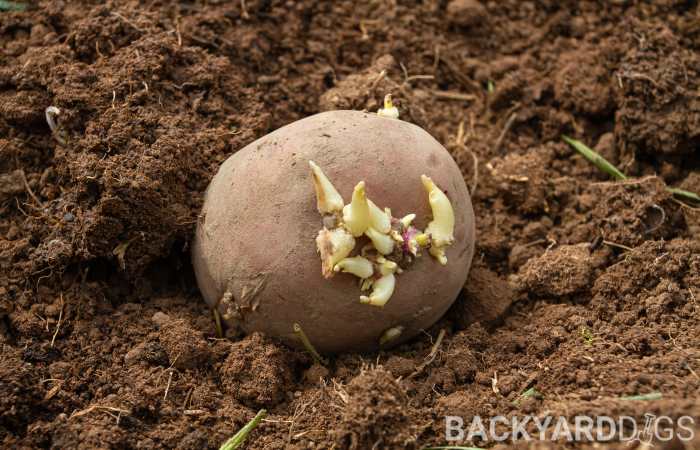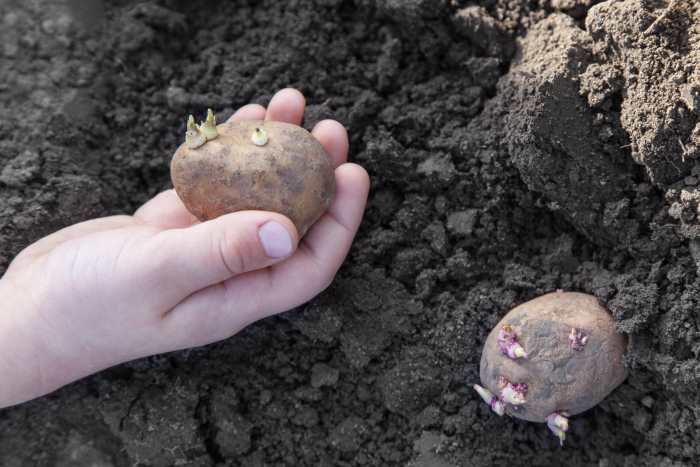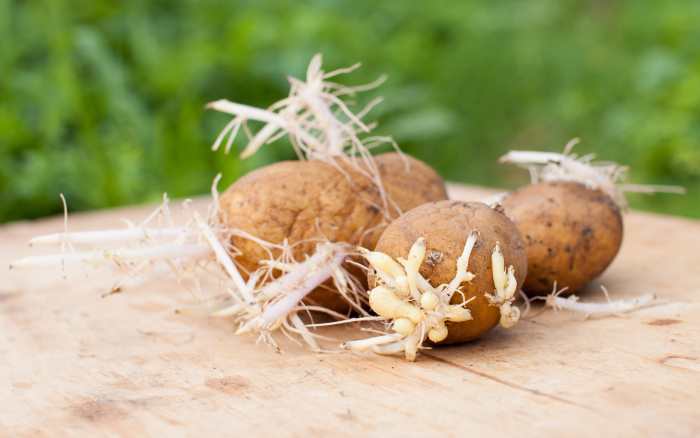Sprouting potatoes are a wonderful thing during planting season, but sometimes you want them to grow earlier.
So is there a way to get potatoes to sprout on demand?

Good news! There are ways to control the timing of sprouting from potatoes. Come along as I explain:
- Why potatoes sprout
- How long it takes for them to sprout
- Ways to sprout potatoes for growing
- Tricks to speed up sprouting
I also answer questions about the safety of using or eating potatoes with sprouts.
With all this information, you’ll be able to confidently begin sprouting your next potato crop on your schedule and avoid some common problems in the process.
Why Do Potatoes Sprout
Potatoes will sprout for a variety of reasons, whether you plant them in the garden or after you harvest and store them for later use.
Exposure to light, even artificial indoor lighting, is one way to trigger sprouts in potatoes.
Warm conditions will cause sprouting. Temperatures above 50 degrees Fahrenheit will do the trick.

Moist conditions cause potatoes to sprout. That’s why gardeners suggest planting potatoes in moist soil and keeping them completely dry during storage.
Storing potatoes near onions or other fruit will accelerate sprouting as gases from ripening produce trigger this reaction.
Related | How Often To Water Potatoes
How Long Does It Take For Potatoes To Sprout
The average sprouting time for potatoes planted in the soil ranges from 7 to 21 days. The sprouting time relies heavily on temperature, sun exposure, and soil moisture levels.
Related | Best Soil Moisture Meters
Because potatoes are a tuber and contain enough nutrients to provide for new growth, they don’t need any soil to sprout.
Potatoes set aside after harvest will begin the formation of sprouts in one to three months if you don’t take steps to deter this from happening.
How To Sprout Potatoes For Growing
I love jump-starting my spring potato crop by sprouting my seed potatoes before setting them in the garden.
Related | Seed Potatoes vs Regular Potatoes
Here are some quick steps for sprouting or “chitting” potatoes for growing:
Step 1 – Prep your seedlings & Chitting

Begin your preparation two to four weeks before you plan to plant your potatoes outdoors.
Two-inch-diameter potatoes with three to five eyes each create a decent crop. You can cut potatoes with more eyes into smaller pieces, giving the raw segments extra time to cure over before using them for sprouts.
I do not suggest you use store-bought potatoes for sprouting. Most commercial growers treat retail potatoes with a spray using Chlorpropham to deter sprout growth during transport and while on the store shelf. Mmmm sounds yummy, right?
While the USDA allows sprout inhibitors on commercially-grown potatoes, trying to grow new plants from such a specimen may be a disappointing experiment.
I suggest you just grow your own from organic seed potatoes.
Watch this short tutorial video about potato chitting for more clarity on the subject.
Step 2 – Set up your sprouting trays
You want to set the seed potatoes, eyes upright, inside a tray or container. When using cut segments, make sure the eyes are showing.
The container should have dividers to keep them from touching one another, and from falling over.
The best and cheapest way to do this is to recycle old egg cartons.
I also suggest staggering the placement of your potatoes, so no two are directly next to each other.
Extra space keeps new shoots from breaking and also makes it easier to pick up and transplant the sprouting potato without causing damage.
Step 3 – Show them the light
The last step to get your potatoes to sprout new growth is to expose them to a light source.
Related | How Much Sun Do Potatoes Need?
You can place your trays on a sunny windowsill or set them under a growing lamp.
If you don’t have a sunny window available or the budget to invest in grow lights, don’t worry! Potatoes will begin to sprout with any light exposure; it just may take longer to see results.
How To Speed Up Potato Sprouting
Many gardeners want to get their potatoes in the ground already growing sprouts, but sometimes forget to start chitting their potatoes early.
Luckily, there are ways to speed up potato sprouting when time is of the essence.
The first thing to know is that after harvest, potatoes naturally go into a dormant stage that lasts from four to eight weeks.
- You can bring potatoes out of the dormant stage by setting them in a dark spot in the refrigerator. Leave them for about 15 days, then bring them out and place them in a room with light.
- Another way to speed up sprouting is to bring your potatoes into a warm room. The warmth sends a message to the potato to begin growth.
You can accelerate sprouts by using the effects of ethylene, the gas many vegetables and fruits produce naturally. Enclosing your potatoes inside a paper bag with ripening produce will hurry sprouting action along.
Increasing moisture or humidity around the potatoes is another way to encourage quick sprouting. Layer slightly moist paper towels between potatoes, or use a mister to dampen an empty cardboard egg carton and set potatoes inside.
Related | Germinating Seeds In Paper Towel
Can You Use Potatoes That Have Started To Sprout?

Potatoes from your storage area that have sprouts are safe to plant in the garden or early-starting trays if the timing is right.
If your potatoes have a green color along with sprouts, they are still safe to plant.
If your potato has an abundance of sprouts growing, it’s better to detach some by cutting them off. Ideally, you want to leave three or four shoots on a potato you plan to transfer to your garden.
Just be careful to use gloves or wash hands thoroughly after touching sprouts, because they are full of a toxic chemical called Solanine that potatoes produce to deter pests from attacking the plant as it grows.
Is It Ok To Eat Sprouted Potatoes?
Sprouted potatoes are safe to consume as long as the potato is still firm, and you remove the toxic sprouts and any other areas of green skin or flesh.
Use a knife to scoop out the sprouts and cut off any green portions of the potato. Removal of these areas is sufficient to reduce dangerous toxin ingestion.
Ingesting the sprouts can cause sickness or even death in a high concentration. Symptoms like cramps, nausea, diarrhea, vomiting, dizziness, and headaches are some of the side effects of high Solamine levels.
Many times a potato, after cutting off the sprouts, still tastes bitter. The transformation of starches into sugars at this stage also lower nutritional value. If you have other potatoes, pass on the ones that have sprouted.
In Summary
Potatoes are what every survivalist should grow in his backyard!
Now that you know how to get potatoes to sprout, use this knowledge to speed up your seasonal potato garden harvest.
Another benefit of knowing the factors that affect sprouting is that you can better preserve the potatoes you grow.
I hope you share the information in this guide with your gardening friends and family so they, too, can see better results!












